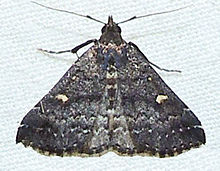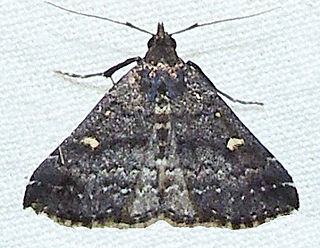
Hypenula is a genus of litter moths of the family Erebidae. The genus was erected by Augustus Radcliffe Grote in 1876.
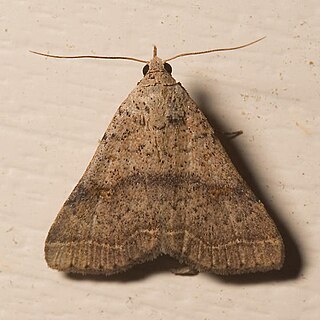
Bleptina is a genus of litter moths of the family Erebidae. It was erected by Achille Guenée in 1854.

Nigetia is a monotypic moth genus in the family Erebidae. Its only species, Nigetia formosalis, the thin-winged algibelle or thin-winged owlet moth, has a scattered distribution in eastern North America from Ontario to Connecticut, south to Florida and Texas. Both the genus and the species were first described by Francis Walker in 1866.
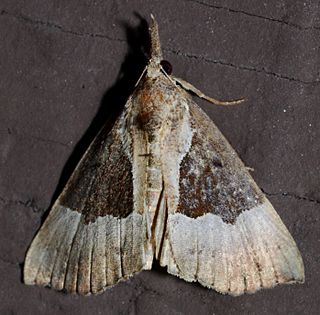
Hypena bijugalis, the dimorphic bomolocha, dimorphic hypena or toothed snout-moth, is a moth of the family Erebidae. The species was first described by Francis Walker in 1859. It is found in North America from Nova Scotia across southern Canada to Vancouver Island, south over the whole United States to Florida.

Hypena edictalis, the large bomolocha, is a moth of the family Erebidae. The species was first described by Francis Walker in 1859. It is found in North America from Quebec and Maine south to Virginia and Kentucky, west to the foothills of Alberta and the Peace River area of British Columbia.
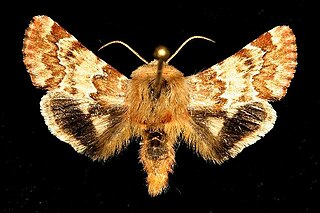
Schinia septentrionalis, the northern flower moth, is a moth of the family Noctuidae. The species was first described by Francis Walker in 1858. It is found in North America from Missouri to Quebec to South Carolina and Louisiana. Records include Colorado, Oklahoma, South Dakota and Texas. It is listed as threatened in the US state of Connecticut.
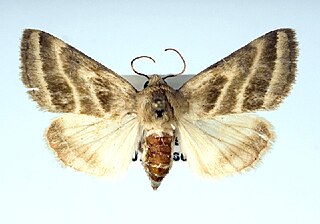
Schinia trifascia, the three-lined flower moth, is a moth of the family Noctuidae. The species was first described by Jacob Hübner in 1818. It is found in North America from Ontario and Massachusetts south to Florida and west to Arizona, Colorado and Wyoming. It has also been reported from Louisiana.
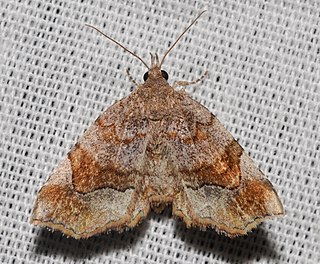
Pangrapta decoralis, the decorated owlet, is a moth in the family Erebidae. The species was first described by Jacob Hübner in 1818. It is found in North America from Alberta to Nova Scotia south to Florida and Texas.
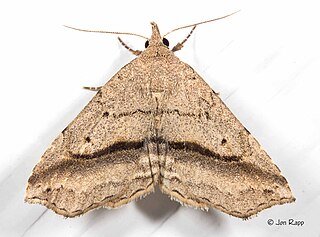
Ledaea perditalis, the buttonbush owlet or lost owlet moth, is a moth in the family Erebidae. The species was first described by Francis Walker in 1859. It is found in North America from the Great Lakes states, Quebec and northern New England, south to Florida and Texas.

Phalaenophana pyramusalis, the dark-banded owlet, is a moth of the family Erebidae. The species was first described by Francis Walker in 1859. It is found in North America from Saskatchewan to Nova Scotia, south to North Carolina and Texas.

Phalaenostola eumelusalis, the punctuated owlet or dark phalaenostola, is a moth of the family Erebidae. The species was first described by Francis Walker in 1859. It is found in North America from New Brunswick, North Dakota and South Dakota to Maine, south to Georgia and Iowa. In the north it is also found in Saskatchewan.

Tetanolita floridana, the Florida owlet or Florida tetanolita moth, is a litter moth of the family Erebidae. The species was first described by J. B. Smith in 1895. It is found in the United States from Wisconsin to Long Island, south to Florida and Texas.

Renia salusalis, the dotted renia, is a litter moth of the family Erebidae. The species was first described by Carl Linnaeus in his 1758 10th edition of Systema Naturae. It is found in the United States from Colorado, Ohio and Connecticut, south to Florida and Texas.

Renia factiosalis, the dark-banded renia or sociable renia moth, is a litter moth of the family Erebidae. The species was first described by Francis Walker in 1859. It is found from southern Canada to Florida and Texas.
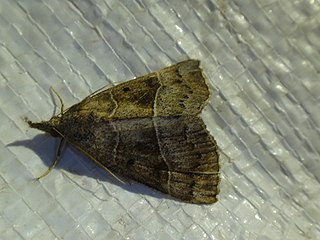
Hypena deceptalis, the deceptive hypena or deceptive bomolocha moth, is a moth of the family Erebidae. The species was first described by Francis Walker in 1859. It is found in North America from Manitoba to Quebec, south to Florida and Texas. It is absent from much of Gulf Coastal Plain though.

Hypena manalis, the flowing-line hypena, is a moth of the family Erebidae. It is found from Minnesota to Nova Scotia, south to Florida and Texas.

Hypena abalienalis, the white-lined hypena or white-lined bomolocha moth, is a moth of the family Erebidae. The species was first described by Francis Walker in 1859. It is found from southern Canada to northern Florida and Texas.
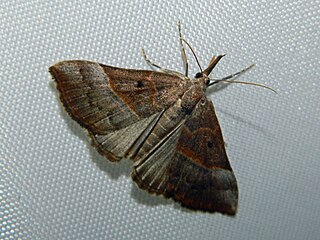
Hypena eductalis, commonly known as the red-footed snout, red-footed bomolocha moth, or alder smoke, is a species of moth in the family Noctuidae. The species was first described by Francis Walker in 1859. It is found in North America from Saskatchewan to Nova Scotia and south to Florida and Texas.
Phytometra rhodarialis, the pink-bordered yellow, is a moth of the family Erebidae. The species was first described by Francis Walker in 1859. It is found from southern Ontario in Canada and Missouri and New Hampshire in the United States, south to Florida and Texas in the United States, possibly only as stray northward.
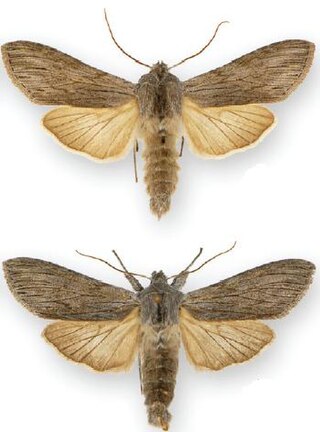
Cucullia intermedia, the dusky hooded owlet, intermediate cucullia, goldenrod cutworm or intermediate hooded owlet, is a moth of the family Noctuidae. The species was first described by Adolph Speyer in 1870. It is found from coast to coast across southern Canada and the northern United States, south in the west to California and to Pennsylvania in the east. In the Rocky Mountains it is found south to the White Mountains in east-central Arizona and occurs commonly in Utah, Colorado and north-eastern Nevada.
